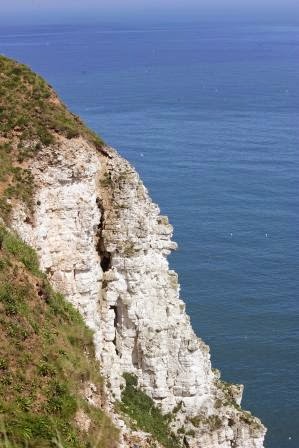Holidaying for the first time on the
North Yorkshire coast and being unfamiliar
with the area left me wondering how much bird life I might encounter. I need not have worried. I had amazing experiences at two contrasting
sites.
The first visit was to Filey Dams
Nature Reserve. This is a small wetland
site managed by the Yorkshire Wildlife Trust.
It comprises freshwater lagoons surrounded by marsh and grassland grazed
by cattle. It is the largest remaining
freshwater marsh in the region. The
reserve is approached through an estate of bungalows not giving a clue to the
gem that lies behind it.
 |
| Filey Dams: Bur-Marigold pond [Pic: Jones] |
The second and most spectacular site
was RSPB Bempton Cliffs, located midway between Filey and Flamborough Head. What a jewel this site is. Our experience was helped by good weather,
but I doubt that much can detract from the wonders of Bempton at this time of
the year. It presents a real onslaught
on the senses: the sights, sounds and smells are spectacular. More than 200,000 birds inhabit the imposing chalk
cliffs.
At first the sight is
challenging; it is difficult to appreciate just how many birds are perching
precariously on the cliffs and how many more are in the sea below.
 |
| Chalk cliffs, Bempton [Pic:Jones} |
 |
| Gannets and guillemots nesting, Bempton Cliffs [Pic: Jones} |
The balletic movement of Gannets, Guillemots,
Razorbills, Kittiwakes, and Herring Gulls was mesmerising and all achieved
without any choreography. How do they
avoid bumping into each other? Convoys of Gannets patrolled along the seascape
while Puffins performed their clumsy flight as they headed for footholds on the
cliffs. All species were nesting on the
cliffs. It doesn’t take much to realise
that 200,000 birds produce plenty of guano and the smells were witness to that!
 |
| Razorbills, Bempton Cliffs [Pic:Jones] |
The RSPB team does much to educate at this site with regular Puffintasia events and Puffin and Gannet Seabird cruises around the cliffs. Boards are dispersed around the site encouraging visitors to reflect on different elements of Puffin ecology.
No description or photograph can do justice to this site. Apart from the bird cornucopia, there is a wealth of wildflowers, invertebrates and soils. This site is a must to visit if you have the slightest interest in seabirds and their ecology.
 |
| Education board [Pic: Jones} |
 |
| Well surfaced paths are feature of main access areas at the reserve [Pic: Jones} |
Further information about RSPB
Bempton Cliffs can be found at: http://www.rspb.org.uk/reserves/guide/b/bemptoncliff

1 comment:
Ok how fast can a Puffin fly Jen? They don't strike me as speed merchants.
Bempton is Brill, but good heads up for the Bur-Marigold Pond
Thanx lowra
Post a Comment